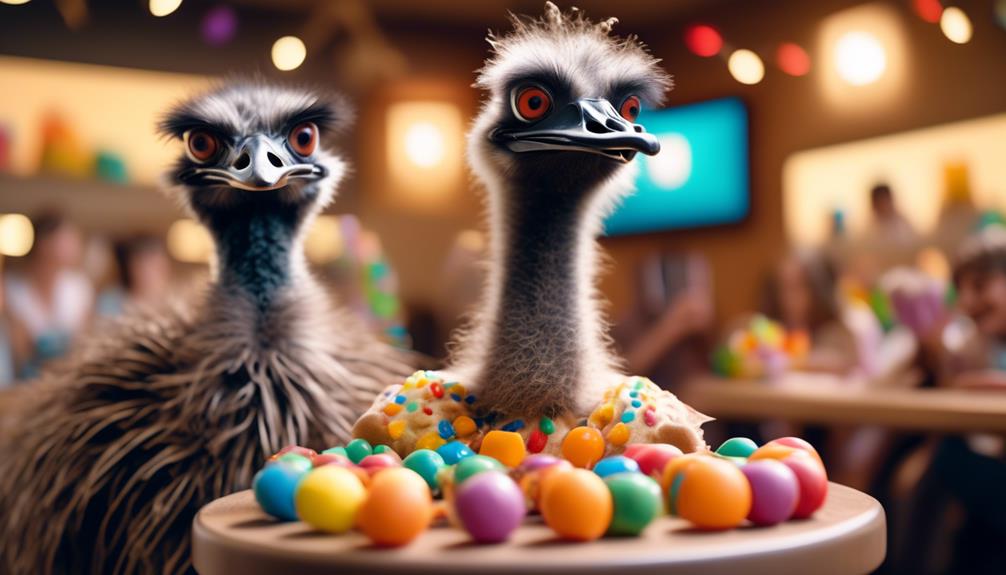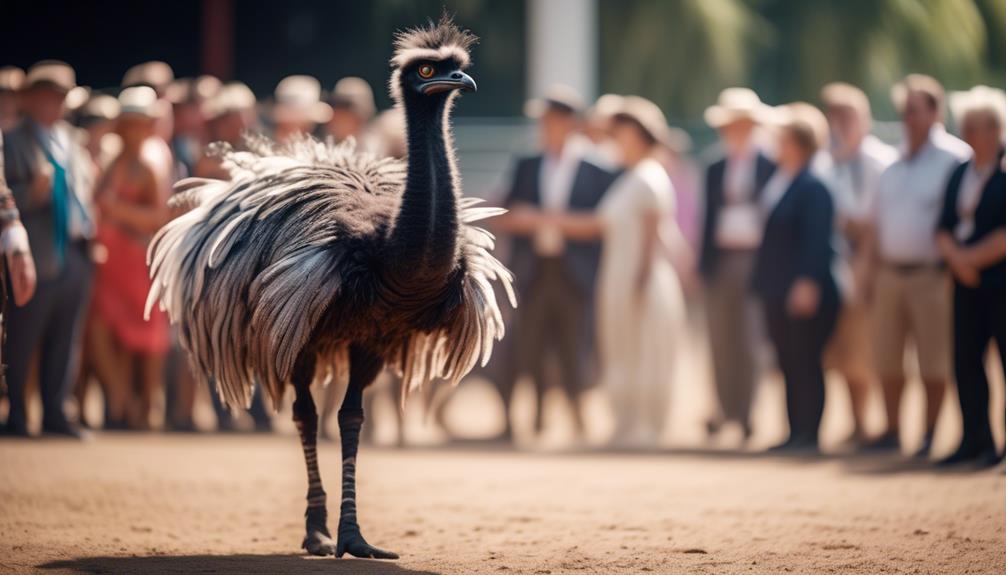
Welcome to the fascinating world of training your emu, where the path to success is as elusive as a shimmering mirage in the desert. With their unique personalities and peculiarities, emus require diligent effort and a dash of ingenuity to be trained effectively.
But fear not, for in this discussion, you will discover the secrets to building a deep bond with your emu, mastering positive reinforcement techniques, and unlocking their full potential.
So, are you ready to embark on this extraordinary journey, where the rewards are as grand as the outstretched wings of an emu in flight? Get ready to unveil the captivating tips and methods that will pave your way to emu training triumph.
Key Takeaways
- Building trust is essential for effective emu training, and it can be achieved through spending quality time together and respecting their personal space preferences.
- Setting up a safe and spacious training area, using sturdy equipment, and establishing a consistent training routine are important for successful training sessions.
- Positive reinforcement techniques, such as clicker training and using food rewards, are highly effective in strengthening the bond with the emu and encouraging desired behaviors.
- Teaching basic commands, addressing problem behaviors with patience and consistency, and socializing the emu for handling and veterinary care are crucial aspects of emu training.
Understanding Emu Behavior
To effectively train your emu, it's crucial to have a deep understanding of their behavior, allowing you to anticipate their actions and tailor your training approach accordingly.
Emus communicate through body language and vocalizations, which provide valuable insights into their mood and intentions.
Emu body language includes various postures and movements. When an emu is relaxed, it will stand tall with its feathers flat against its body. However, if it feels threatened or agitated, it may puff up its feathers and lower its head, signaling that it's ready to defend itself. Additionally, emus often sway their bodies from side to side, which can indicate curiosity or a desire to establish dominance. Understanding these body language cues will help you interpret your emu's emotions and respond appropriately during training sessions.
Emu vocalizations are another important aspect of their behavior. These large birds produce a range of sounds, from low grunts and drumming noises to high-pitched calls. For instance, a deep booming sound often indicates aggression or a warning to potential threats, while softer, melodic calls are associated with contentment and social bonding. By listening to and recognizing these vocalizations, you'll gain valuable insights into your emu's current state of mind, allowing you to adjust your training methods accordingly.
Building Trust With Your Emu
Building trust with your emu is a crucial step in successfully training and bonding with these fascinating birds. Emus are highly intelligent and sensitive creatures, and by building a bond based on trust, you can establish a strong foundation for a harmonious relationship.
Here are three key ways to build trust with your emu:
- Spend quality time together: Emus thrive on companionship and interaction. Regularly spend time with your emu, engaging in activities like walking, grooming, or simply sitting in their presence. This will help them feel comfortable and secure in your presence.
- Respect their boundaries: Emus have personal space preferences, just like humans. Understand and respect their comfort zones, and gradually work towards building trust by gradually expanding those boundaries. This will create a safe environment where your emu feels respected and understood.
- Be consistent and patient: Trust takes time to develop, so it's important to be consistent in your interactions and patient with the process. Emus are perceptive creatures, and they'll appreciate your reliability and patience as you work towards building a bond.
Setting Up a Training Area

When setting up a training area for your emu, it's important to create a designated space that's safe, secure, and conducive to learning. Choosing the right training equipment and creating a safe and stimulating training environment are key factors in ensuring successful training sessions with your emu.
Firstly, selecting the appropriate training equipment is crucial. Emus are large, powerful birds, so it's essential to use equipment that's sturdy and durable. A strong and well-fitted harness is necessary for controlling your emu during training exercises. Additionally, consider using positive reinforcement tools such as clickers or target sticks to effectively communicate with your emu and reward desired behaviors.
Next, focus on creating a safe and stimulating training environment. Emus require a spacious area to move around freely, so ensure that your training space is adequately sized. Remove any potential hazards or distractions to prevent accidents during training sessions. Providing a variety of enriching toys and obstacles will keep your emu engaged and motivated to learn.
Remember to establish a consistent routine and maintain a calm and positive atmosphere during training. Emus respond well to patience, consistency, and gentle guidance. By setting up a training area that prioritizes safety and stimulation, you can create an optimal learning environment for your emu and foster a strong bond between you both.
Establishing a Training Routine
Now that you have set up a safe and stimulating training area for your emu, it's time to establish a consistent training routine that will help you effectively communicate with your bird and reinforce desired behaviors.
Establishing a training schedule is essential for maximizing the effectiveness of your training sessions. Consistency is key when it comes to teaching your emu new behaviors and ensuring that they retain what they've learned.
Here are three key benefits of establishing a training schedule:
- Improved Focus: By following a regular training routine, your emu will become accustomed to the training sessions and will be more focused on learning and interacting with you. This will make it easier for you to communicate your expectations and reinforce positive behaviors.
- Enhanced Bonding: Regular training sessions provide an opportunity for you and your emu to spend quality time together. Through consistent interaction, trust and mutual understanding will develop, strengthening the bond between you and your bird.
- Increased Engagement: Incorporating play into your training sessions not only makes them more enjoyable for your emu but also enhances their engagement and motivation to learn. Emus are naturally curious creatures, and incorporating play into training can stimulate their minds and keep them actively involved.
Using Positive Reinforcement Techniques

To effectively train your emu, employing positive reinforcement techniques is crucial for encouraging desired behaviors and building a strong bond with your bird. Positive reinforcement involves rewarding your emu for exhibiting the desired behavior, which increases the likelihood of them repeating that behavior in the future. Two effective methods of positive reinforcement in emu training are clicker training and incorporating food rewards.
Clicker training is a popular technique used to teach emus specific behaviors. It involves using a clicker, a small handheld device that makes a distinct clicking sound, to signal to your emu that they have performed the desired behavior correctly. The clicker acts as a bridge between the behavior and the reward, making it easier for your emu to understand what they are being rewarded for.
Incorporating food rewards is another effective way to reinforce positive behaviors in emus. Emus are highly motivated by food, so using treats as rewards can be very effective in training. Choose small, easily consumable treats that your emu finds particularly enticing. This could include fruits, vegetables, or specially formulated emu treats. When your emu performs the desired behavior, immediately offer them the treat as a reward. This will help them associate the behavior with a positive outcome and encourage them to repeat it.
By using clicker training and incorporating food rewards in your emu training, you can effectively reinforce positive behaviors and strengthen the bond with your bird. Remember to be consistent, patient, and always use positive reinforcement techniques to create a positive and rewarding training experience for your emu.
| Positive Reinforcement Techniques for Emu Training | Description | Benefits |
|---|---|---|
| Clicker Training | Use of a clicker to signal correct behavior | Clear communication, quick and precise reinforcement |
| Incorporating Food Rewards | Using treats as rewards for desired behavior | Motivates emu, strengthens positive association with behavior |
Teaching Basic Commands
To teach basic commands to your emu, begin by establishing a strong foundation of trust and positive reinforcement techniques. Emus are intelligent creatures and can learn a variety of commands with patience and consistency. Here are three effective methods for teaching basic commands to your emu:
- Start with simple commands: Begin by teaching your emu basic commands like 'sit' or 'stay.' Use hand signals and verbal cues consistently, and reward your emu with treats and praise when they respond correctly. This will help them understand the desired behavior.
- Break down complex commands: For more advanced skills, break down complex commands into smaller steps. For example, if you want your emu to wave its wing, start by teaching them to lift their wing first. Then gradually add the waving motion. This incremental approach will make it easier for your emu to understand and learn.
- Troubleshoot common training issues: Emus can sometimes become stubborn or distracted during training sessions. If your emu isn't responding to a command, take a step back and assess the situation. Is there a distraction in the environment? Are you using clear and consistent cues? Adjust your training approach accordingly to address any issues that arise.
Addressing Problem Behaviors

Once you have established a solid foundation of trust and positive reinforcement techniques with your emu, it's important to address any problem behaviors that may arise.
Dealing with aggression in emus can be a challenging task, but with the right approach, it's possible to correct these behaviors. Emus may exhibit aggression towards humans or other animals, especially during breeding season or when they feel threatened.
To address aggression, it's essential to identify the triggers and gradually desensitize your emu to them. This can be done by exposing them to the trigger in a controlled environment and rewarding calm behavior.
Correcting destructive behaviors in emus, such as scratching or pecking at furniture or plants, requires redirection and providing appropriate outlets for their natural behaviors. For example, providing scratching posts or designated areas for pecking can help redirect their destructive tendencies.
Additionally, ensuring that your emu has enough mental and physical stimulation can reduce the likelihood of destructive behaviors.
Socializing Your Emu
Socializing your emu is an important aspect of their development and overall well-being. Emus are highly social animals that thrive in groups, and providing them with opportunities to socialize can greatly enhance their quality of life. Here are three reasons why socializing emus in a group is crucial:
- Emotional well-being: Emus are known to form strong bonds within their social groups. Socialization allows them to engage in natural behaviors, such as grooming and playing, which contribute to their emotional well-being. Being part of a group also helps prevent loneliness and boredom, reducing the risk of behavioral problems.
- Learning and development: When emus interact with other members of their species, they learn important social skills and behaviors. They observe and imitate each other, honing their communication and problem-solving abilities. Socializing emus from a young age helps them develop into well-adjusted adults.
- Exercise and stimulation: Group socialization provides emus with opportunities for physical exercise and mental stimulation. They engage in activities like running, chasing, and exploring their environment together, which helps keep them physically fit and mentally stimulated.
Introducing emus to other animals can also be beneficial for their socialization. It exposes them to different species, promoting tolerance and adaptability. When introducing emus to other animals, it's important to do so gradually and under controlled conditions to ensure their safety and well-being.
Training for Handling and Veterinary Care

Training your emu for handling and veterinary care is essential for ensuring their health and well-being. Proper handling techniques are crucial to ensure both your safety and the well-being of your emu. When handling your emu, it's important to approach them calmly and confidently. Emus may become startled or defensive if approached too quickly or aggressively. Always approach from the side, avoiding direct eye contact, as this may be perceived as a threat.
Additionally, it's important to familiarize your emu with basic veterinary procedures such as nail trimming, beak maintenance, and regular check-ups. Start by introducing your emu to these procedures gradually, using positive reinforcement techniques such as treats or praise. This will help build trust and make future veterinary care much easier.
Proper nutrition and diet are also essential for the health and well-being of your emu. Emus are omnivores and their diet should consist of a variety of foods including fruits, vegetables, grains, and protein sources such as insects or small animals. It's important to provide a balanced diet to ensure they receive all the necessary nutrients. Consult with a veterinarian or an avian nutritionist to determine the specific dietary needs of your emu. Additionally, ensure access to fresh water at all times and monitor their food intake to prevent overeating or nutritional deficiencies.
Enhancing Physical Fitness Through Training
To enhance the physical fitness of your emu, incorporate a variety of training exercises that promote strength, flexibility, and cardiovascular endurance. Keeping your emu physically fit is essential for its overall health and well-being.
Here are three effective methods to enhance your emu's physical fitness through training:
- Balanced Nutrition: A healthy diet is crucial for your emu's physical fitness. Provide a balanced diet that includes a mix of fruits, vegetables, grains, and protein sources like insects and worms. Ensure they have access to clean water at all times.
- Regular Exercise: Emus require regular exercise to maintain their physical fitness. Encourage activities like walking, running, and swimming to improve their strength and cardiovascular endurance. Set up a spacious area for them to roam and explore, allowing them to engage in natural behaviors.
- Mental Stimulation: Incorporating mental stimulation in emu training can also contribute to their physical fitness. Provide toys, puzzles, and interactive games that encourage problem-solving and keep their minds active. This mental engagement can help prevent boredom and promote overall well-being.
Training for Show or Performance

For optimal success in show or performance, it is important to focus on specific training techniques that highlight your emu's unique abilities and qualities. Showmanship training is a crucial aspect of preparing your emu for the spotlight. It involves teaching your emu to perform specific behaviors and movements on cue, showcasing their natural grace and beauty. Performance techniques, on the other hand, are designed to enhance your emu's overall stage presence and captivate the audience.
To better understand the different aspects of training for show or performance, let's take a look at the table below:
| Training Technique | Description |
|---|---|
| Target Training | Training your emu to touch a specific target with its beak or foot, perfect for choreography. |
| Feather Fluffing | Teaching your emu to fluff its feathers on command, adding visual appeal to its performance. |
| Walking on Hind Legs | Training your emu to walk on its hind legs, showcasing its balance and agility. |
| Vocalization Control | Teaching your emu to make specific vocalizations on cue, adding a unique element to its act. |
Maintaining Consistency and Patience
After honing specific training techniques for show or performance, the next key aspect to consider is maintaining consistency and patience throughout the training process. Consistency is crucial in teaching your emu new behaviors and reinforcing existing ones. By consistently using the same commands, gestures, and rewards, you create a clear and predictable environment for your emu to learn and thrive.
Patience is equally important as training an emu can be a time-consuming process. It requires dedication and perseverance to overcome setbacks and challenges that may arise along the way.
To help you stay consistent and patient during emu training, here are three important tips:
- Importance of rewards in emu training: Emus are highly motivated by rewards, such as treats or praise. Use positive reinforcement techniques to reward desired behaviors, and be consistent in your delivery. This will strengthen the association between the behavior and the reward, making it more likely for your emu to repeat the desired action.
- Dealing with setbacks and challenges during emu training: Emus, like any other animal, may face setbacks or challenges during training. It's important to remain patient and calm when this happens. Assess the situation, identify the root cause, and adjust your training approach if needed. Remember that setbacks are a normal part of the learning process, and with time and consistency, you can overcome them.
- Take breaks and manage your expectations: Emu training can be mentally and physically demanding for both you and your emu. Take regular breaks to prevent burnout and frustration. Additionally, it's essential to manage your expectations and understand that training progress may vary from emu to emu. Celebrate small victories and be patient with the overall progress.
Frequently Asked Questions
Can Emus Be Trained to Perform Complex Tricks or Stunts?
Yes, emus can be trained to perform complex tricks or stunts. Advanced emu behavior training techniques can be used to teach them these skills. With patience and consistency, you can achieve impressive results.
How Long Does It Typically Take to Train an Emu to Respond to Basic Commands?
On average, it takes about 6-8 weeks to train an emu to respond to basic commands. Special needs emus require unique training techniques, and positive reinforcement plays a crucial role in their training success.
Can Emus Be Trained to Interact With Other Household Pets?
When it comes to training an emu to socialize with other household pets, it's important to manage their interactions carefully. Emus can be trained to coexist peacefully with other animals, but it will require patience, consistency, and proper supervision.
What Is the Best Age to Start Training an Emu?
Starting emu training at a young age has numerous benefits. The impact of training age on emu behavior is significant. Early training establishes a strong foundation, improves socialization skills, and enhances overall obedience.
Are There Any Specific Health Concerns or Precautions to Consider When Training an Emu?
When training your emu, it's important to consider any potential health concerns or precautions. Make sure to use proper emu training methods and equipment to ensure their safety and well-being.
Conclusion
In conclusion, training your emu requires understanding their behavior, building trust, and establishing a training routine. Using positive reinforcement techniques and maintaining consistency and patience are key to successful training.
One interesting statistic to note is that emus can reach speeds of up to 30 miles per hour, making them one of the fastest running birds in the world.
By training your emu effectively, you can enhance their physical fitness and potentially even train them for show or performance purposes.




